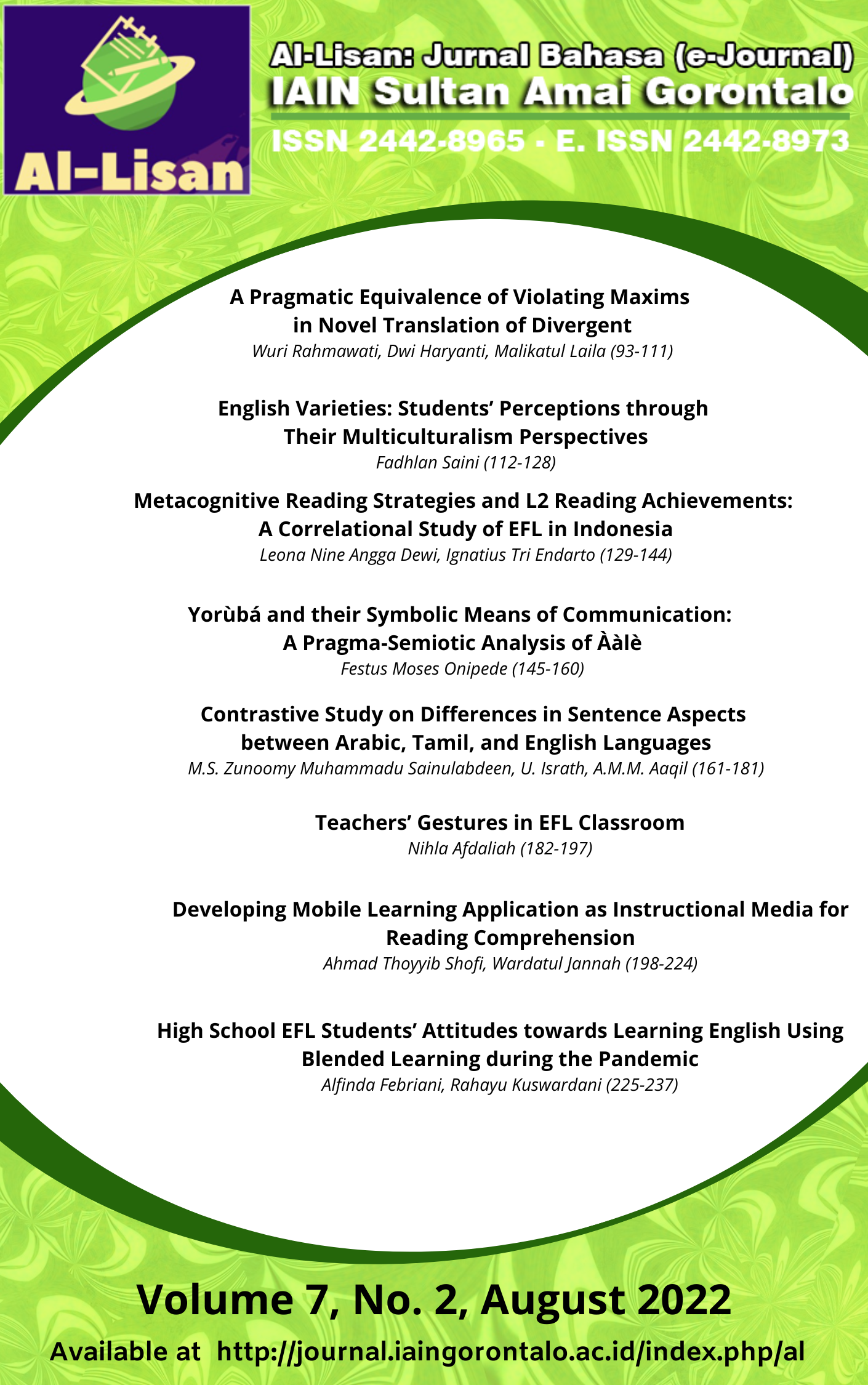English Varieties: Students’ Perceptions through Their Multiculturalism Perspectives
DOI:
https://doi.org/10.30603/al.v7i2.2585Keywords:
Students’ awareness of multiculturalism;, English variety;, sociolinguisticsAbstract
This research aimed at finding out the students’ perceptions toward their awareness in multiculturalism and to reveal the correlation of their perceptions on the use of their English varieties. To obtain the data, it was employed mix-method design by going through some steps. Seen through qualitative side, it was utilized descriptive qualitative method in which the researcher figured out the description of students’ awareness of multiculturalism and its position to the use of their English varieties. Meanwhile, in quantitative side, the researcher employed the calculation of the questionnaire by passing the SPSS program to measure out correlation of them both. It was intended to figure out the calculation of the questionnaire results between both perceptions, if there was any relationship. Findings showed that their perceptions were vary. It can be seen by the reflection of their activities of the external and internal activities of their own. Those activities were linked to explain that, by having multicultural awareness, students could define the methodology in enhancing their expression of English varieties. Additionally, within these activities, students could try to socialize and expand their ability in expressing English language variety by confidently as well as pleasantly.
Downloads
References
Agus, G., & Narty, A. (2020). English students’ awareness of American Englis hand British English differences. LINGUA Jurnal Pendidikan Bahasa, 16(1), 36–52. https://doi.org/https://doi.org/10.34005/lingua.v16i1.851
Al Hosni, S. (2014). Speaking difficulties encountered by young EFL learners. International Journal on Studies in English Language and Literature (IJSELL), 2(6), 22–30. www.arcjournals.org
Budiarsa, I. M. (2017). Language, dialect and register sociolinguistic perspective. RETORIKA: Jurnal Ilmu Bahasa, 1(2), 379. https://doi.org/10.22225/jr.1.2.42.379-387
Hermini, H. (2019). Students’ perception toward American and British English in Cokroaminoto University. IDEAS: Journal on English Language Teaching and Learning, Linguistics and Literature, 7(1), 1–11. https://doi.org/10.24256/ideas.v7i1.724
Ladegaard, H. J., & Sachdev, I. (2006). ‘I like the Americans… but i certainly don’t aim for an American accent’: Language attitudes, vitality and foreign language learning in Denmark. Journal of Multilingual and Multicultural Development, 27(2), 91–108. https://doi.org/10.1080/01434630608668542
Lauder, A. (2008). The status and function of English in Indonesia: A review of key factors. Makara Human Behavior Studies in Asia, 12(1), 9. https://doi.org/10.7454/mssh.v12i1.128
Lubis, A. Y. (2004). Memahami “cultural studies” dan multikulturalisme dari perspektif pascamodern. Wacana, 6(2). http://wacana.ui.ac.id/index.php/wjhi/article/view/350/326
Morgan, M. (2007). Speech community. A companion to linguistic anthropology, 1–22. https://doi.org/10.1002/9780470996522.ch1
Mykhailyuk, O., & Pohlod, H. (2015). The languages we speak affect our perceptions of the world. Journal of Vasyl Stefanyk Precarpathian National University, 2(2–3), 36–41. https://doi.org/10.15330/jpnu.2.2-3.36-41
Nishanthi, R. (2018). The importance of learning English in today world. International Journal of Trend in Scientific Research and Development, Volume-3(Issue-1), 871–874. https://doi.org/10.31142/ijtsrd19061
Nye, M. (2007). The challenges of multiculturalism. Culture and Religion, 8(2), 109–123. https://doi.org/10.1080/14755610701458915
Ohazuruike, K., Distribution, I., Distribution, I., & Through, G. (2019). International Journal of Social Sciences Uluslararası Sosyal Bilimler Dergisi. August, 100–121.
Pavlína Stelzerová. (2014). Department of English language and literature teaching differences between British and American English in lower-secondary EFL classes Supervisor : Mgr . Barbora Müller Dočkalová.
Resmini, S. (2019). EFL students’ perception towards the use of bahasa. ELTIN JOURNAL, Journal of English Language Teaching in Indonesia, 7(1), 12–22. https://doi.org/10.22460/eltin.v7i1.p12-22
Riani, A. A. (2016). Understanding the rules of language acquisition in. Al-Lisan, Vol. 1 No. 1 (2016): Al-Lisan: Jurnal Bahasa (e-Journal), 1–16. https://journal.iaingorontalo.ac.id/index.php/al/article/view/324/279
Safa, A. (2015). British VS American English for university students teaching purposes:The case of Third-Year EFL students at Tlemcen University. Master’ Degree in Language Studies, People’s Democratic Republic Of Algeria, 13–14.
Shi, R., & Conrad, S. A. (2009). Correlation and regression analysis. Annals of Allergy, Asthma and Immunology, 103(4 SUPPL.). https://doi.org/10.1016/s1081-1206(10)60820-4
Shinta, M. N., & Darmawati, B. (2021). Nonverbal communication of supervisors in the mentoring thesis process: Perceptions of English students. Al-Lisan, 6(1), 1–11. https://doi.org/10.30603/al.v6i1.1347
Siregar, S. (2017). The In fl uence of dialect...., Syahreni Siregar, 27-36. 5(1), 27–36.
Teddlie, C., & yu, F. (2007). Mixed methods sampling: A typology with examples. Journal of Mixed Methods Research, 1(1), 77–100. https://doi.org/10.1177/2345678906292430
Zarbaliyev, H. (2017). Multiculturalism in globalization era: History and challenge for Indonesia. International Journal of Scientific Studies, 13(1), 1–16.
Downloads
Published
How to Cite
Issue
Section
License
Copyright (c) 2022 Fadhlan Saini

This work is licensed under a Creative Commons Attribution-ShareAlike 4.0 International License.
Copyright Notice
Authors who publish in Al-Lisan: Jurnal Bahasa (e-Journal) agree to the following terms:
- Authors retain copyright and grant the journal right of first publication with the work simultaneously licensed under a Attribution-ShareAlike 4.0 International (CC BY-SA 4.0) License that allows others to share the work with an acknowledgment of the work's authorship and initial publication in this journal.
- Authors are able to enter into separate, additional contractual arrangements for the non-exclusive distribution of the journal's published version of the work (e.g., post it to an institutional repository or publish it in a book), with an acknowledgment of its initial publication in this journal.
- Authors are permitted and encouraged to post their work online (e.g., in institutional repositories or on their website) prior to and during the submission process, as it can lead to productive exchanges, as well as earlier and greater citation of published work.












